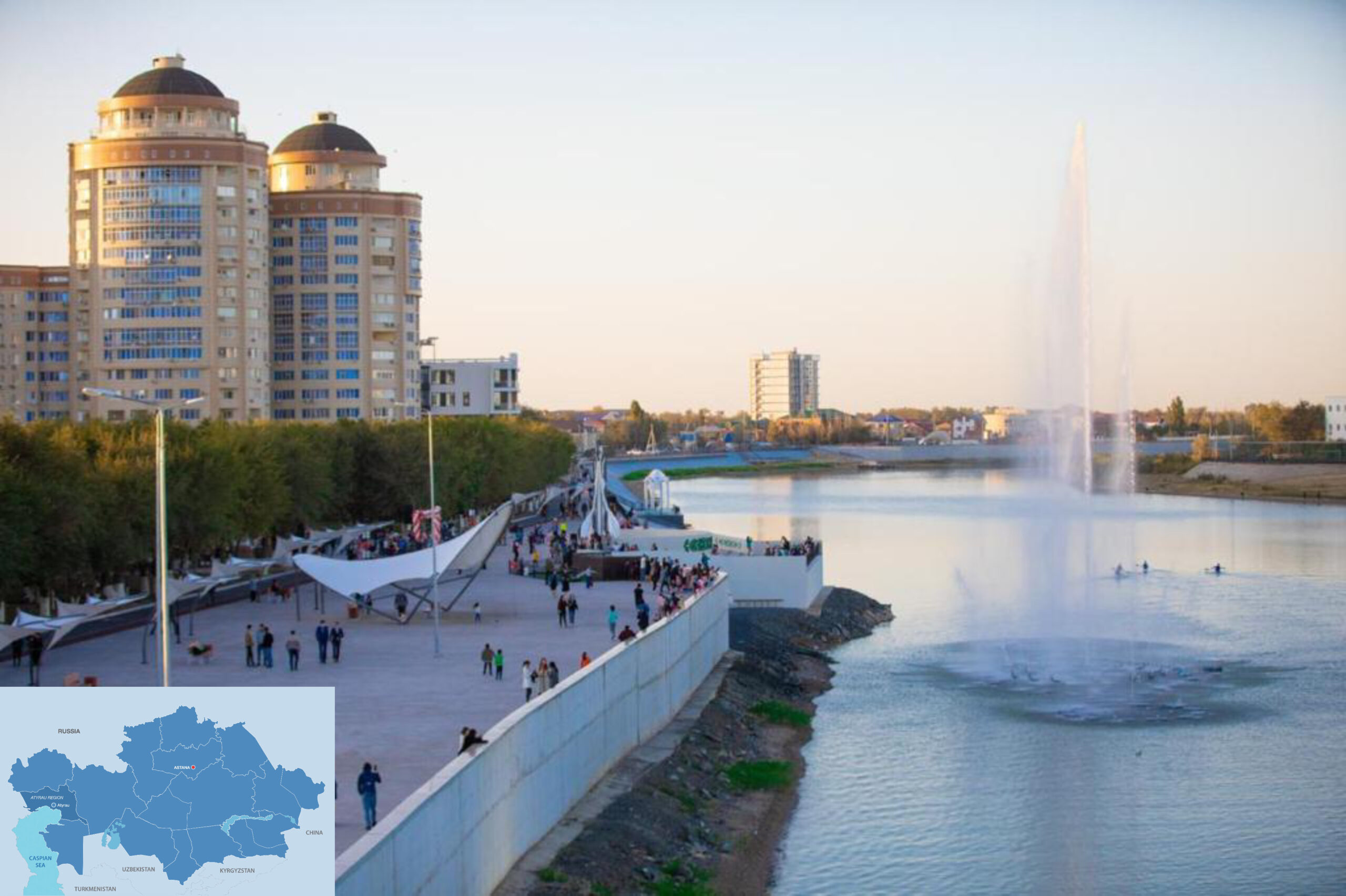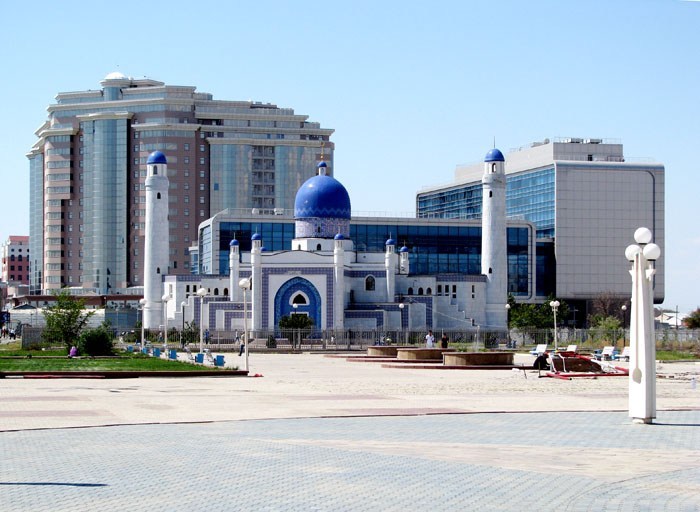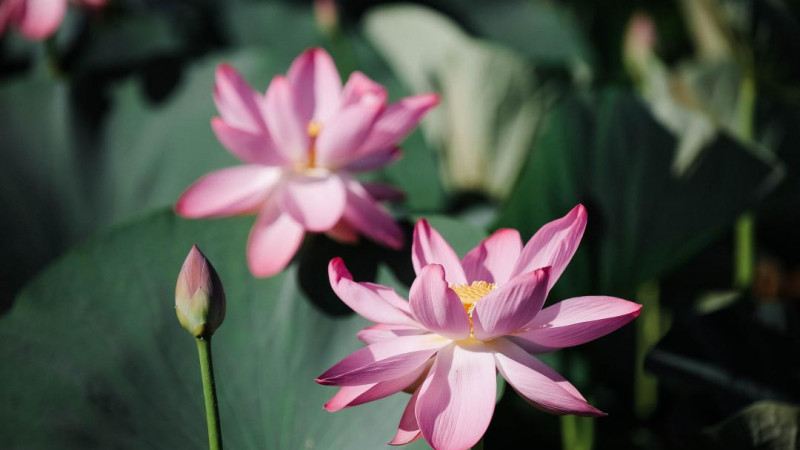Editor’s Note: The Astana Times continues its series of articles, Exploring Kazakhstan, City by City, in the marvelous city of Atyrau. We are setting out to unveil the rich diversity of cities to bring you closer to the heart and soul of Kazakhstan.
ASTANA – Atyrau, a city straddling Asia and Europe, is where the oil industry thrives alongside a rich fishing heritage. This blend of industries has shaped the city’s identity, attracting workers and families drawn to the promise of prosperity.

Zhaiyk River embankment. Photo credit: gov.kz Click to see the map in full size. The map is designed by The Astana Times.
The city is located in the Caspian lowlands in western Kazakhstan, at the mouth of the Zhaiyk River, and is the regional center of the Atyrau Region.
The region’s history stretches back centuries, with the first records dating to the third and fourth centuries B.C.
Atyrau traces its origins to 1615, when entrepreneur Mikhail Guryev established a settlement after securing a monopoly from Tsar Mikhail Fedorovich to fish for sturgeons at the mouth of the Zhaiyk River. In return, Guryev was tasked with building fortifications to protect the town from raids and providing red caviar for the tsar’s table.
The city was known as Guryev until 1992, when it reclaimed its original name, Atyrau.
Oil industry
Just a few kilometers from the city lies a giant oil and gas field known as Tengiz (which means “sea” in Kazakh). Located 350 kilometers southeast of Atyrau, the field was first discovered in 1979. Atyrau evolved into an oil town, pioneering refineries, followed by an oil equipment plant.
An oil well monument stands on the city’s major road, its piston pump nodding in rhythm, signifying the importance of what became a major industry in the city and the region.

Gas processing facilities at the Tengiz oilfield in Kazakhstan. Photo credit: upstreamonline.com.
The community of a relatively small town found its population booming, with an ever-growing migrant workforce coming to town seeking oilfield jobs.
“Although Atyrau might not seem an appealing city, it has a way of gradually drawing you in,” said Aigerim Bulambayeva, who moved there to work at one of the oil companies.
“Many people, like myself, come for a year of work to add a line to their resume, but end up staying much longer. My colleagues, who have been working here almost since the oil company was founded, came from different parts of Kazakhstan, and now they are raising the third generation of Atyrau residents,” she said.
According to Bulambayeva, Atyrau’s dullness is what makes it a place for those who are mature not only physically but also mentally.
“You must become independent and learn how to organize your leisure time. People who are already settled and mature come here. You can see them strolling leisurely along the new embankment and sitting at breakfast without a worry. You can’t even find a free table in a café on weekends,” she said.
Visitors and locals can stroll along the embankment of the Zhaiyk River, enjoying the scenic views and fresh air. Many also visit the Isatai and Makhambet alley, a peaceful promenade lined with greenery, or stop by the central mosque, a striking symbol of the city’s culture and spirituality.

Central mosque of Atyrau city. Photo credit: amin.kz
The bridge that connects the two halves of Atyrau—the European and Asian sides divided by the Zhaiyk River—is also a popular spot for taking photos, especially during sunsets.
Each year, the city’s entertainment scene expands, with new cafes, karaoke bars and restaurants opening up, bringing a livelier atmosphere to the once-quiet town.
Fish industry
Outside of oil, the most precious commodity in Atyrau is fish and caviar.
The Caspian Sea and the Zhaiyk River were once abundant in fish. Fishing has long been vital to the city’s economy and remains part of its identity, symbolized by the sturgeons and oil derrick proudly displayed on its coat of arms.

Fishing industry once flourished in the Atyrau Region. Photo credit: azh.kz
In 1930, the Gigant (Giant) fishing collective farm was established, and by the end of that year, Guryevsky district had ranked first in the Soviet Union for fish catches, contributing 6.5 million pods of fish to the country. At the beginning of the 20th century, fishing was the only economic activity in the provincial district town of Guryev.
The fishing industry in the region is experiencing a revival, with an increasing number of new enterprises dedicated to commercial fish cultivation. In the Atyrau Region, dozens of fisheries are involved in commercial fishing, targeting 19 species that inhabit the Caspian Sea, including mullet, sprat and herring, as well as kutum, which has been removed from Kazakhstan’s Red List of endangered species. The annual kutum fishing limit for Atyrau is set at 10 tons.
Nearby places to visit
Approximately 50 kilometers from Atyrau on the banks of the Zhaiyk River is the ancient city of Saraishyk. Founded in the 10th or 11th century, it was an important stop on the caravan route from Europe and the Golden Horde capital to Iran, India and China. The city thrived as a major trade hub, minting coins and developing pottery. Near the archaeological site is a memorial complex with a museum, a small mosque and a pantheon.

This magical flower has touched many civilizations and religions as a symbol of purity. Photo credit: Atyrau Region’s communication service.
Another popular domestic tourist attraction is the lotus fields in the Kigash River delta, the second most significant river after the Zhaiyk. In spring and summer, visitors can witness beautiful lotus landscapes spanning dozens of hectares. The Caspian lotuses, known for their uniquely delicate pink color, are the northernmost in the world.
The series previously featured Zhezkazgan, Shymkent, Taldykorgan, Oskemen, Kostanai, Karagandy Taraz, Kokshetau, Semei and Petropavl.


